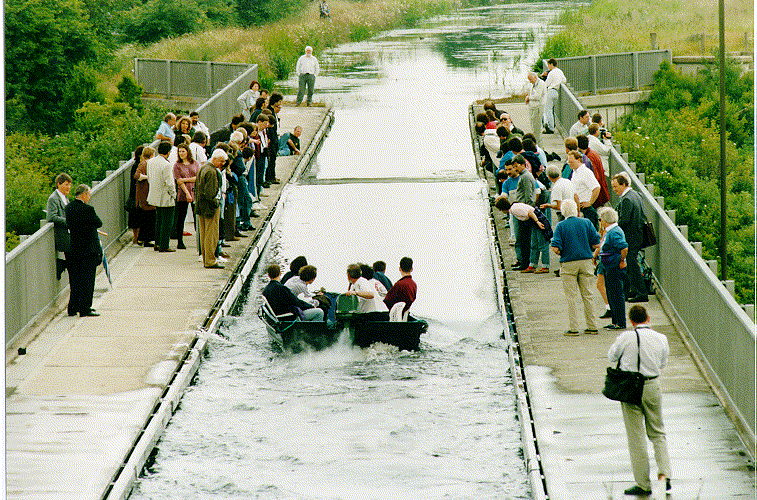How A Scottish Naval Engineer And His Horse Discovered Solitons

Image Credit: Department of Mathematics, Heriot-Watt University
Daniel Giovannini looks at the incredible contribution that one man and his horse (and the Union Canal) made to modern science.
Although no reliable, easily accessible records are available on this topic, it is probably safe to say that not many mathematical discoveries have ever been made on horseback. It may or may not have been sunny in August 1834. The weather conditions for that fortuitous day are unknown but, for the sake of realism and to set the scene, let us just assume that it was overcast, with a light drizzle. The story takes place in the Scottish countryside, on the Union Canal at Hermiston, near Edinburgh. At the time naval engineer John Scott Russell, born and educated in Glasgow, was working on the design of the keels of canal boats. In Hermiston, Russell was riding his horse, following and observing a boat being rapidly drawn along the canal by a pair of horses. As he later recounted in a nicely penned report for the British Association for the Advancement of Science [lref id=1], what he noticed when the boat suddenly stopped was a most unusual wave that detached from the prow.
The swell quickly moving away from the boat and J. Scott Russell’s insight turned out to be surprisingly resilient. It also had a rather unexpected, though tardy, impact on mathematics and applied mathematics. Such a wave would later be dubbed a soliton and, in the following decades and throughout the twentieth century, would play a central role in the theory of nonlinear differential equations, hydrodynamics, nonlinear optics and communications engineering.
What Russell saw was a wave rolling forward “with great velocity, assuming the form of a large solitary elevation, a rounded, smooth and well-defined heap of water”. This beautiful but subtly odd phenomenon was enough for him to spur his horse and go on the pursuit. The wave kept travelling along the canal, at about 14 km/h when Russell overtook it, apparently undisturbed and preserving its form (a bump of about 40 centimetres in height, extending for some 9 metres). At least two of the properties that would later be recognised as defining characteristics of solitons must have been at once apparent to Russell: the shape of the wave remained stable and, although propagating forward, localised at each instant within a certain region without the dispersion that we would usually associate with an ordinary wave, which instead would eventually flatten out or topple over.
The chase lasted for a mile or two, after which Russell lost sight of the persistent wave in the windings of the canal. Following prolonged investigations performed using a tank built in his back garden for this very purpose, Russell concluded that the strange behaviour of what he called the wave of translation was due to the relative shallowness and narrowness of the canal. The stable waves produced in such a body of water at odds with the principles of hydrodynamics known in the mid-19th century, also showed bizarre particle-like behaviours: a wave of translations too big could split into two, and two waves propagating at different velocities wouldn’t merge, but rather overtake each other and carry on undisturbed.
The first full theoretical treatment of Russell’s wave of translation also known as solitary wave, or soliton, was only published in the 1870’s by Joseph Boussinesq and Lord Rayleigh. The first mathematical model of waves on shallow water surfaces was published much later, in 1895, by Diederik Korteweg and Gustav de Vries. What is now known as the Korteweg-de Vries equation is the prototypical textbook nonlinear partial differential equation whose solutions can be exactly and unambiguously found. Solitons constitute one of its families of solutions. This fact shouldn’t surprise us at all, since solitons were in fact first observed as waves propagating along shallow water surfaces, which is just what Korteweg and de Vries had set out to describe.
Russell went on with his life. He single-handedly revolutionised naval design and made the first experimental observation of the Doppler effect. During all this time, though, he was convinced that his wave of translation would one day be considered of fundamental importance.
In many instances, the scientific method is all about accumulating evidence that either supports or refutes existing hypotheses, models and theories that haven’t yet been put to the test. Sometimes, those models and theories just have to be put aside, waiting to be picked up at some point in the future by someone who can put those nifty mathematical tools to good use. And in fact, while mathematicians kept finding soliton solutions popping up everywhere in new, increasingly complex nonlinear systems, during the second half of the 20th century solitons started finding practical applications, for instance, in optics — where solitons’ intrinsic stability comes in handy when designing optical fibres for long-distance transmission.
Solitons also appear in the description of many optical phenomena that involve nonlinear crystals (where the optical properties of the crystal do not respond linearly to the electric field of the incoming light), as well as optical fibres. These effects now constitute the basic toolbox of modern optics, and have been the subject of active research and countless fundamental and technological applications since the invention of the laser. As the same nonlinear models describe a wide range of physical systems, similar at least from the mathematical side, solitons also appear in the treatment of phenomena as diverse as shock waves and plasma, low-frequency oscillations in complex chemical structures such as DNA and fluid dynamics.
Solitons are, in a way, a recurring trait in the family tree of nonlinear differential equations. Furthermore, they also show up among the families of solutions of other equations that are directly related to, or nonlinear generalisations of, equations that shaped our understanding of the quantum world. The Schrödinger equation in its most basic form is one of the foundations of quantum mechanics. Introduced by Erwin Schrödinger in 1926, the equation that now goes by his name describes the time evolution of the quantum state associated with a physical system. The nonlinear version of the equation and its soliton solutions, moving through obscure mathematical backdoors, appear in the analysis of the interactions of some classes of subatomic particles. At the same time, however, the nonlinear Schrödinger equation can also help describe rogue waves: unusually large spontaneous ocean surface waves that represent a threat even to bulkier ships and ocean liners.
Solitons are an excellent example of a ubiquitous mathematical concept that, after being modelled over a simple physical system, have turned up in a wide variety of disciplines. If one day you happen to be cycling along the Union Canal and a barge stops nearby, look out for the solitary wave it may generate and follow it. It could get you far.
References
- Russell JS. Report of the Committee on Waves, appointed by the British Association at Bristol in 1836. Published in the BA reports VI, 417–468; 1837.
- Emmerson GS. John Scott Russell: A Great Victorian Engineer and Naval Architect. John Murray; 1977.
- Whitham GB. Linear and Nonlinear Waves. John Wiley & Sons; 1974.











1 Response
[…] żródło: https://the-gist.org/2012/07/how-a-scottish-naval-engineer-and-his-horse-discovered-solitons/ […]